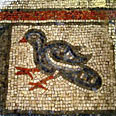



The secrets of an ancient synagogue, dating from around the 3rd to 6th century CE, were discovered completely by accident near Kibbutz Maoz Haim. In 1974, during construction work on an army post west of the kibbutz, Avshalom Yaakovi, a founder of the kibbutz and specialist on the Land of Israel, discerned a mosaic floor, partly buried under the dirt, depicting what looked to him like a menora (traditional Jewish candelabra).

Construction work was stopped, and the Antiquities Authority arrived at the kibbutz. Excavations uncoverd an ancient synagogue.

Underneath a the remains of a Bedouin cemetery, built on the ruins of an old Arab village, a Jewish town from the third century was found. The synagogue, constructed during the latter part of the century, served the Jewish community there for over 300 years, and was destroyed, along with the rest of the the town, in a large fire which broke out during the Arab occupation of the land.

According to signs found in the area, the Jewish town was called Bala, and the Bedouins too kept that name.
The synagogue was constructed during three periods. It was first built as a simple structure, and as circumstances improved in the Jewish community, the synagogue was renovated in the basilica style. It faced Jerusalem, and a wonderful mosaic floor including images of a bird, grapes, and a yellow fruit (apparently a citron) are displayed.




- Travelers are invited to visit the site. Please call ahead of your visit: Avshalom, 04-6064642















